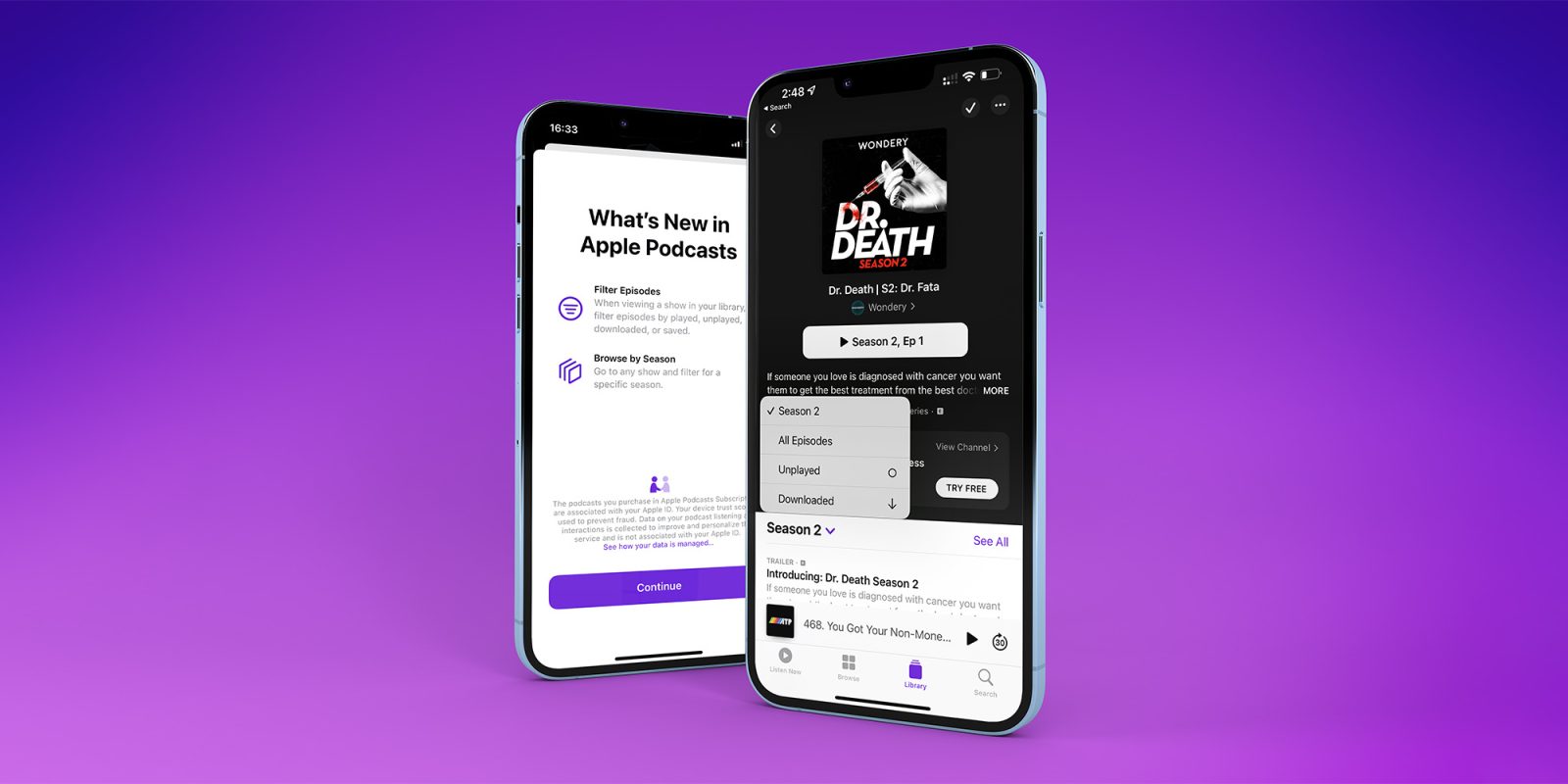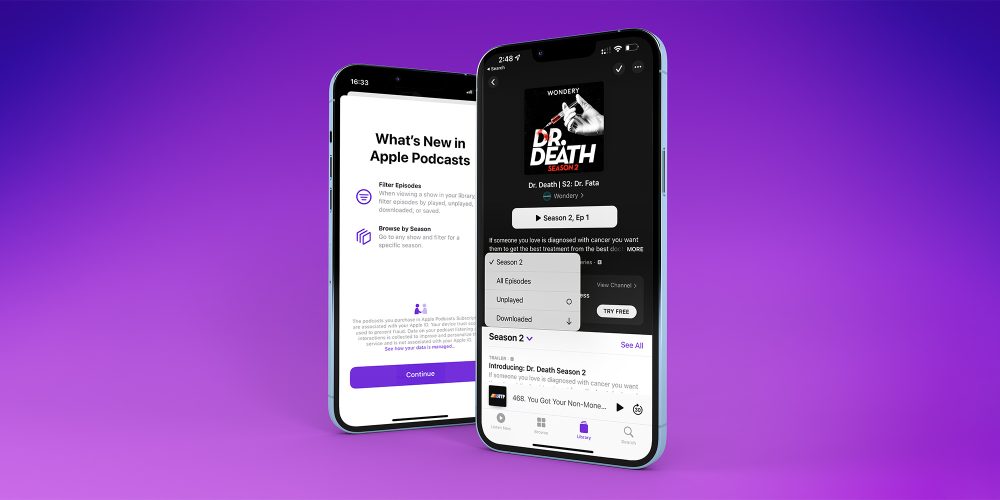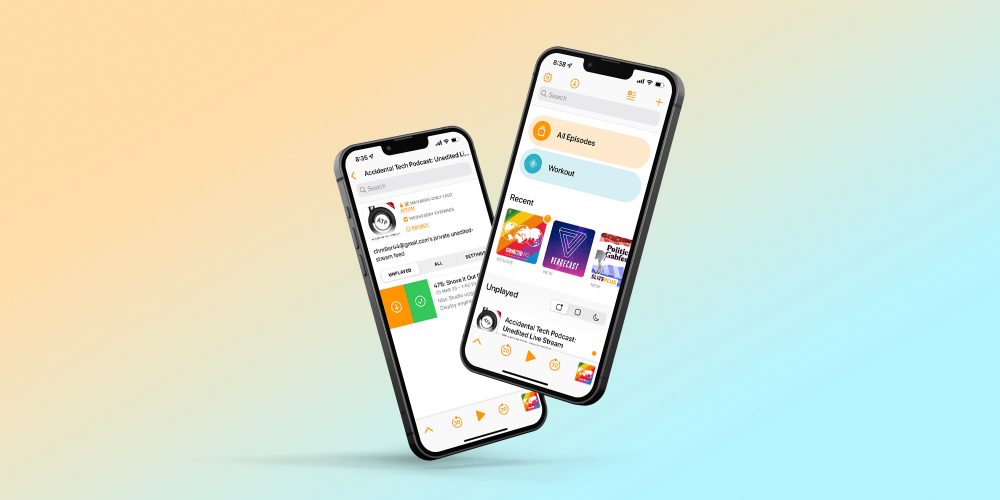
When it comes to listening to podcasts on iOS, there are so many great options. The Apple Podcasts app comes built into every iOS device with syncing. It’s undoubtedly a great app, but is it the best? On iOS, users have countless third-party options. My goal for this article is to break down some of the major podcast apps and help you determine which is best for what you want out of an app. What’s the best podcast app for iPhone?
Table of contents
Is Apple Podcasts the best podcast app for iPhone?
Apple Podcasts is the dominant player in the podcast app market. Usage-wise, it’s one most popular podcast apps on smartphones.
It’s got a lot of good things going for it. It’s built right into every iOS device. It has a native app for tvOS and macOS as well. On Apple Watch, it’s one of the best ways to listen to podcasts when away from your iPhone as it supports streaming over LTE. I think it does a great job of recommending new shows as well. I wish it would include a “social” aspect similar to Apple Music, though.
The overall design fits right into iOS. It’s very similar to Apple Music. On the bottom menu, it includes Listen Now, Library, Browse, and Search. Listen Now shows you the unfinished podcast episodes from shows you subscribe to or one-off episodes you have added.
Library will show you a list of all the shows you have added to your subscription list. Browse will allow you to browse the Apple Podcasts directory by featured, top charts, and by category. Search will allow you to search for specific shows.

Syncing playback position and unplayed episodes across devices is a bit of a struggle on Apple Podcasts. I am not sure why Apple can’t figure this aspect out. If you plan to use Apple Podcasts, I advise that you only use it on an iPhone and maybe an Apple Watch. I wrote an article back in 2021 that details my frustrations with the service.
One of the most unsung features of the Apple Podcast app is to create “Stations.” This feature is under the Library section. If you tap on the Edit button, you’ll see the New Station option. This feature will allow you to group podcasts together that you can trigger via Siri. If you listen to a couple of morning shows like The Daily and Up First, you can group them in a “Morning News” station.
I’d love to see Apple invest in adding functionality like the ability to follow friends, share snippets of a show, more options around playback (voice boost, smart speed, etc.), password-protected feeds, and just overall stability. As Spotify continues to grow its market share, Apple is hopefully going to invest in not only exclusive content but also its app, as well.
You should use Apple Podcasts if you want the default Apple experience on macOS, iOS, tvOS, and watchOS. It lacks some advanced functionality that other apps offer, but it holds its own. Is it the best podcast app for iPhone? If you want the default Apple experience, it’s a pretty solid choice.
Overcast

Overcast has been around since 2013 and has a significant following. In the tech-podcast community, I’d argue it’s the most popular outside of Apple Podcasts. Overcast’s design strikes a nice balance between following modern iOS design standards, but remaining unique. The default color scheme is light and unobtrusive. The main navigation includes a list of your playlists, subscriptions, and buttons to manage your subscriptions and playlists further.
One of the features it brought to the mainstream was the trim silence feature. Before Overcast, a few smaller apps had implemented it, but I prefer how it sounds with Overcast. Smart Speed is described as a way to “pick up extra speed without distortion.” Smart Speed “dynamically shortens silences in talk shows. Conversations still sound so natural that you’ll forget it’s on — until you see how much extra time you’ve saved.” For those who want to save some time listening to certain podcasts, yet who don’t want the distortion that comes with 1.5x or 2x speeds, Smart Speed is a happy medium. All of your shows will be shorter, but you likely won’t be able to tell any difference in listening quality.
Voice Boost is a feature that aims to normalize the volume and make shows easier to listen to when in noisy situations, such as a car or airplane. For shows with less-than-ideal editing, Voice Boost can make shows easier to listen to, and it was upgraded to version 2 in early 2020.
Voice Boost 2 is a mastering-quality audio-processing pipeline that applies broadcast-standard loudness normalization, light compression and EQ, and a true-peak lookahead limiter to your podcasts, in real time, without sacrificing quality or battery life. And it runs at less than 1% CPU usage on an iPhone SE.
Overcast, like most apps, is pulling from the Apple Podcasts directory to power its directory. One of the places Overcast excels is with its Now Playing screen. It’s the easiest to use in my experience. I can quickly see show notes, change chapters, or adjust the audio settings. Some of the other great features are clip sharing (sharing a snippet for a show) and AirPlay 2 support, which is helpful for HomePod and Sonos usage.
In March of 2022, Overcast shipped a major new update that overhauls much of the design. If you’ve used the app before, you’ll notice the new design immediately when you open the app for the first time after updating. The home screen features a far more modern design, with an emphasis on new colors, rounded corners, and customization. Macro Arment describes this as the “largest redesign” in the nearly eight-year history of Overcast. The Overcast home screen features your created playlists at the top, which are now fully customizable with colors and icons. Below your playlist, you’ll find a new section for recently played and newly published podcast episodes.
Overcast is a free download, and it will have ads (sold by the developer) in the Now Playing and Directory screens. The ads are generally for other shows, and I’ve found them useful. If you subscribe to the yearly subscription ($10), you can disable ads. You also get a file uploads option if you subscribe. If you find yourself downloading lectures from YouTube (and converting to MP3) or listening to DRM-free audiobooks, you’ll love this feature. You get to enjoy all of Overcast’s playback features with whatever audio you upload as well.
Overcast can be downloaded on the App Store for free.
Spotify

Spotify likely has the second largest market share of all the podcast apps on iOS. If you are a user of its music service, I could see why you’d want to use it for podcasts as well. While it lacks features of some of the other applications, it’s doing some exciting things with playlists and podcast episodes. Overall, it offers bare minimum functionality compared to other apps, though. Spotify is spending a lot of money on content, so it remains to be seen if you’ll need to at least have it downloaded in order to enjoy some of your favorite shows.
Is Spotify the best podcast app for iPhone? You should use Spotify for podcasts if you are a premium subscriber already and you want everything to be inside of one application. Otherwise, there’s no reason to use it. One key thing it lacks is the ability to add your own RSS feed. If a show isn’t in the directory, you cannot add it unless the show is working directly with Spotify. This includes premium shows from places like Relay FM.
Breaker

Breaker is one of the more innovative podcast apps I’ve used, and a lot of apps could learn something about integrating social functionality into their existing apps. As I mentioned earlier with Apple Podcasts, we’re missing a social aspect to podcast listening. With Breaker, you can follow friends to see what they’re listening to, new shows they subscribe to, and shows they “favorite.” You can also comment on shows you listen to and your friends can see it. It’ll show you episodes that are getting a lot of traction as well.
If you are a podcaster, you can even “claim” your show so people who listen to your show can “follow you” and engage further. I think this is a great way to build out the community further. Breaker also includes the ability for podcast hosts to generate revenue from their podcasts inside of Breaker. I’d love to see Apple build a way to support creators inside of Apple Podcasts, as I’d like to be able to support the shows I love.
Breaker’s overall design is lovely. I love how everything is laid out. It feels like a modern reimagining of what a podcast app should look like. From a playback perspective, it includes speeds up to 3x with the option to “skip silences” to speed up shows.
I can’t think of a single thing I don’t like about Breaker. Of all the apps I’ve tried, it is the most unique. If you are bored of all the current podcast apps, you should definitely check out Breaker. It’s a free download on the App Store.
Castro

Castro takes a unique approach to subscription management. You subscribe to shows, but then it uses a queue system to manage the shows. As new episodes come in, you can choose to queue a show or archive it. This feature is helpful if you listen to shows that have daily episodes. If you have favorite shows, you can set them to auto queue, so you never miss them. I love Castro’s innovative approach to library management. If you are someone who struggles with keeping up with new episodes, Castro will be a great fit. Like a lot of the other apps, it includes the ability to use different playback speeds and trim silences (Castro Plus required).
Another one of Castro’s features is the ability to import MP3 files via iCloud Drive. This feature allows you to side-load DRM-free audiobooks or lectures. One of the other apps I looked at (Overcast) supports a similar function, but it is limited to 2GB in total file size (Castro Plus required).
Castro is a free download, but it requires a subscription ($18.99 per year) to unlock additional features like trim silence, enhance voices, night mode, custom app icons, and more. Castro’s overall design is unique and well done. If you are the type that subscribes to a lot of podcasts but only grabs a handful a week, Castro’s functionality is perfect for you.
Castro can be downloaded on the App Store.
Pocket Casts

Pocket Casts has been around the iPhone podcast app scene for about as long as any app has been. One of the features it pioneered was storing your feeds on a server so refreshing is fast and has minimal effects on battery life, and almost all apps have copied it today.
From a design perspective, Pocket Casts is just beautiful. I love the colors it uses along with the fonts. Like a lot of the other apps, it contains multiple playback speeds, a trim silence option, and a voice boost option. In my years of using the app, Pocket Casts’ playlist system is probably the most robust and laid out the best.
Outside of Apple Podcasts, Pocket Casts probably has the best directory layout. While most of the third-party apps simply pull from the Apple Podcasts directory API, how they lay it out is up to them. Pocket Casts’ directory looks great, and it makes it easy to find new shows.
If you are looking for an iPhone app with a native macOS app, Pocket Casts is your best solution. I’ve found its macOS app to be more straightforward to use than the Apple Podcasts app for desktop options. Other apps can now be run on macOS thanks to Apple Silicon, but none of them can match the native macOS feel of Pocket Casts.
Pocket Casts is a free download on the App Store, and Pocket Casts Plus adds free desktop apps, cloud storage for audio, new icons, and more. Pocket Cast Plus is $.99/month or $9.99/year.
Player FM

Player FM is one of the newest apps I’ve been testing. It has a great design with a slick user interface. It’s a free download but offers a premium subscription to unlock some useful features. Similar to Pocket Casts, it offers cross-platform functionality, so you can play your shows from iOS, Android, the web, or even on Chromecast.
In testing the app, one of the aspects I thought was very well done was how you can create categories (playlists) to organize your podcasts. If you bounce around. from various genres like sports, news, and technology, the categories help keep them separated. The directory from Player FM is extremely well-curated, so if you’re the type of person who is always asking for recommendations, Player FM is a great place to start.
Wrap-up on best podcast app for iPhone
Overall, there are lots of great options for podcast apps. If you want a default Apple experience, use Apple Podcasts. If you want social features, Breaker is the best app for you. If you want the best overall audio experience, Overcast is hands down the best. If you subscribe to a lot of shows, Castro can help you manage your now playing list. If you want an Android app or an excellent macOS app experience, check out Pocket Casts.
So what’s the best podcasts app for iPhone? I think Overcast and Pocket Casts are my favorites, but I bounce around between them all to keep learning about new features. I am a power user, and they offer the most power-user features. Breaker has social features that no other app can touch. Castro’s triage system can help you keep up with a lot of shows at once. There are options for all types of users. If you aren’t happy with Apple Podcasts, check out the alternatives. What are your favorites? Let me know in the comments below.
9to5 Podcast Network
Don’t forget about the great lineup of podcasts on the 9to5 Network.
- 9to5Mac Happy Hour
- Watch Time
- Apple @ Work
- 9to5Mac Daily
- Electrek from Electrek.co
- Space Time from Space Explored
- Quick Charge from Electrek.co
- 9to5Toys Daily from 9to5Toys.com
- Alphabet Scoop from 9to5Google.com
- 9to5Google Daily from 9to5Google.com
FTC: We use income earning auto affiliate links. More.







Comments